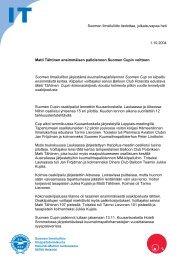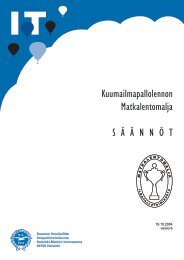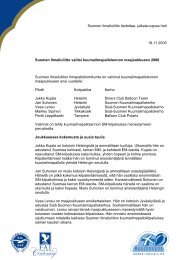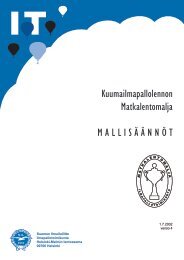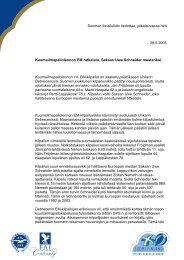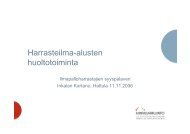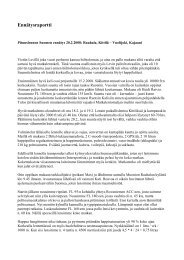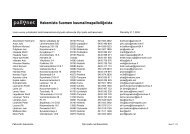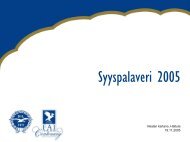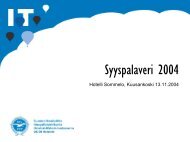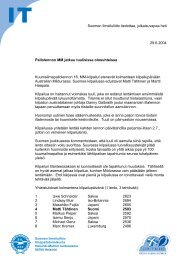FAI Sporting Code - General Section - 2004 Edition - Pallo.net
FAI Sporting Code - General Section - 2004 Edition - Pallo.net
FAI Sporting Code - General Section - 2004 Edition - Pallo.net
Create successful ePaper yourself
Turn your PDF publications into a flip-book with our unique Google optimized e-Paper software.
2.2.1.4 Class D: GLIDER - A fixed wing aerodyne capable of sustained soaring flight and having no means<br />
of propulsion.<br />
(AL5)<br />
MOTOR GLIDER: A fixed wing aerodyne equipped with means of propulsion, capable of sustained<br />
soaring flight without thrust from the means of propulsion.<br />
(AL5)<br />
2.2.1.5 Class E: ROTORCRAFT - An aerodyne that derives the whole or a substantial part of its lift from a<br />
rotary wing system.<br />
AUTOGYRO: A rotorcraft the wings of which are not provided with any form of direct power drive.<br />
HELICOPTER: A rotorcraft with a power driven rotor system whose axis (axes) is (are) fixed and<br />
substantially perpendicular to the longitudinal axis of the rotorcraft.<br />
TILT ROTORCRAFT: An aerodyne which derives the whole or a substantial part of its lift for<br />
vertical or hovering flight by tilting rotor(s) upward to a position substantially vertical, and in<br />
forward flight derives its lift from rotors and/or wings, and is capable of autorotation in the event of<br />
power failure.<br />
2.2.1.6 Class F: MODEL AIRCRAFT - An aircraft of limited dimensions, with or without a power source,<br />
not able to carry a human being.<br />
(AL7)<br />
2.2.1.7 Class G: PARACHUTE - A collapsible device designed to counteract gravity using forces exerted<br />
upon it by the air.<br />
2.2.1.8 Class H: VERTICAL TAKE-OFF AND LANDING AEROPLANE - An aeroplane capable of taking<br />
off, maintaining hovering or forward flight and landing while obtaining the whole of its lift directly<br />
from the thrust of one or more jet engines installed in and integral to the aeroplane and not<br />
requiring lift derived from external surfaces during take-off or landing.<br />
2.2.1.9 Class I: HUMAN-POWERED AIRCRAFT - An aerodyne which takes off and remains airborne<br />
using solely the muscular energy of one or more persons on board. It may not employ any systems<br />
of static support (gas, hot air, etc.) and may not carry any kind of apparatus which could receive<br />
energy during the flight but may carry apparatus to store muscular energy after take-off.<br />
2.2.1.10 Class K: SPACECRAFT - Vehicle capable of flight in space.<br />
2.2.1.11 Class M: TILT-WING/TILT ENGINE AEROPLANE - An aircraft capable of both horizontal and<br />
vertical flight which, in forward horizontal flight, derives most of its lift from fixed wings and which<br />
achieves vertical or hovering flight by tilting the wings or engine(s) upward to a position<br />
substantially vertical.<br />
2.2.1.12 Class N: SHORT TAKE-OFF AND LANDING (STOL) AIRCRAFT - An aeroplane capable of takeoff<br />
and landing in a short distance.<br />
2.2.1.13 Class O: HANG GLIDER - A glider capable of being carried, foot launched and landed solely by the<br />
use of the pilot's legs. (AL 1)<br />
PARAGLIDER: A hang glider with no rigid primary structure.<br />
2.2.1.14 Class P: AEROSPACECRAFT - A craft capable of flight in space and of sustained and controlled<br />
flight in the atmosphere. It must also be capable of soft touch-down on land or sea. (AL 1)<br />
2.2.1.15 Class R.<br />
MICROLIGHT: A one or two seat aeroplane with a specified maximum mass and characterised by a<br />
very low wing-loading.<br />
POWERED HANG GLIDER: A hang glider fitted with means of propulsion capable of launching it<br />
and sustaining flight.<br />
<strong>FAI</strong> <strong>Sporting</strong> <strong>Code</strong> <strong>General</strong> <strong>Section</strong> <strong>2004</strong><br />
2-2<br />
Ch 2 - Definitions



